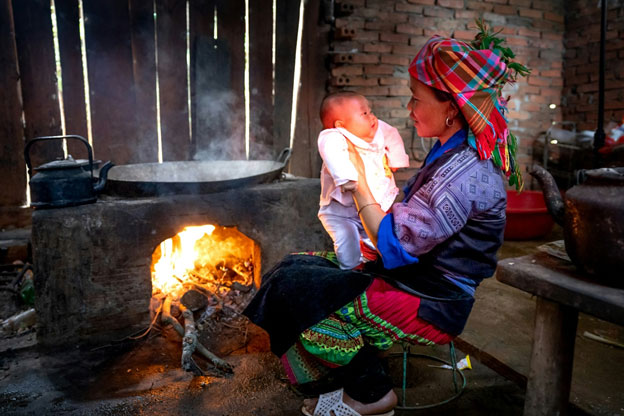Our Terms & Conditions | Our Privacy Policy
Can the Asia-Pacific Region Deliver Clean, Affordable Energy by 2030?
Asia-Pacific, Climate Change, Development & Aid, Environment, Featured, Headlines, Natural Resources, Sustainable Development Goals, TerraViva United Nations, Trade & Investment
Opinion
Armida Salsiah Alisjahbana is United Nations Under-Secretary-General and Executive Secretary of ESCAP
An Asian mother is taking care of her baby while cooking with traditional stove. Approximately one billion people in Asia and the Pacific still rely on traditional polluting cooking fuels that lead to poor indoor air quality. Credit: Unsplash/Quang Nguyen Vinh
BANGKOK, Thailand, Aug 28 2025 (IPS) – The future of the global energy landscape will be shaped by Asia and the Pacific. Over the past two decades, our region has been the principal driver of global energy demand and emissions. Energy has powered prosperity, lifted millions out of poverty and transformed societies.
This progress, however, has come at a cost: widening inequalities, entrenched fossil fuel dependencies and increasing climate vulnerability – which make achieving the Sustainable Development Goals (SDGs) and climate objectives challenging.
The gaps we must close
What will it truly take for the region to realize the energy transition and achieve SDG 7 – clean, affordable, reliable and modern energy for all – by 2030? The new Regional Trends Report on Energy for Sustainable Development shows that universal access to electricity is within reach. Yet other dimensions of sustainable energy require urgent acceleration.
Clean cooking remains the most pressing challenge. Nearly one billion people in Asia and the Pacific still rely on traditional fuels, exposing households – especially women and children – to dangerous levels of indoor air pollution. Renewable energy is growing, although the pace still falls short of what is needed to meet rising demand and lower emissions at the scale required.
Per capita, Asia and the Pacific’s installed renewable energy capacity remains lower than in other parts of the world. At the same time, energy efficiency continues to be underutilized, leaving untapped potential to reduce consumption, lower energy costs and reduce carbon emissions.
These challenges are compounded by emerging pressures. Securing access to and sustainably developing critical raw materials is essential for advancing energy transitions, while expanded regional power grid connectivity is crucial to improving energy security and keeping electricity affordable.
Rapidly growing sectors, such as data centres, also need to shift toward low-carbon pathways. Meeting these priorities will demand strategic planning, coordinated action and a strong commitment to fairness and equity.
Emerging momentum
The Asia-Pacific region is showing encouraging signs in recent years with many emerging initiatives to draw inspiration from. Subregional initiatives, including the ASEAN Power Grid and the Nepal-India-Bangladesh trilateral power trade, are fostering cross-border electricity exchanges, improving reliability and enabling greater renewable integration.
China and India are at the forefront of renewables, while Pacific countries such as Fiji, Solomon Islands and Vanuatu have set targets for 100 per cent renewable electricity by 2030. Indonesia and the Philippines are expanding geothermal capacity. Grid-scale battery storage in Australia is helping manage renewable fluctuations and strengthen system resilience.
Industries, urban centres and the transport sector are also driving change. Countries are rapidly expanding the adoption of electric vehicles through investment and infrastructure. Japan and Singapore are improving building energy efficiency with strict standards and incentive programmes, and the Republic of Korea is deploying smart grid technologies to optimize usage.
These examples illustrate that innovation, investment and cooperation are creating the conditions for scalable energy progress across the region.
A just transition for all
The energy transition is not only a technological shift, but also a social transformation. For many such as workers in fossil fuel industries, those in energy-poor households and youths entering the job market, the transition will be a lived reality. Reskilling, education and social protection must accompany this shift, while creating decent jobs in the renewable and energy efficiency sectors.
Women are disproportionately affected by energy poverty and remain underrepresented in the energy workforce and decision-making roles. Unlocking women’s full participation in the sector is needed to accelerate innovation and inclusive growth. A just energy transition must be gender-responsive, with policies and investments designed to close gaps in access, employment and leadership.
Turning ambition into action
Three ingredients stand out:
- 1. Ambition in policy and planning. Countries need bold, integrated policies that align national energy plans with climate commitments, including net-zero targets. This means setting higher renewable energy ambitions, phasing down coal dependency, embedding energy efficiency into every sector, and ensuring policies are just and inclusive.
2. Scaled-up investment. Delivering SDG 7 requires mobilizing trillions in sustainable energy investment. Governments alone cannot bear this burden. De-risking mechanisms, innovative financing and public-private partnerships will be critical to unlock capital flows.
3. Regional cooperation. Regional grid integration and cross-border power trade, and shared approaches to the development of critical energy transition minerals and technology standards can create efficiencies and resilience.
The region has shown that transformative change is possible. Just twenty years ago, hundreds of millions lacked access to electricity. Today, universal access is within reach, proving that the seemingly insurmountable gaps in clean cooking, renewable deployment and efficiency can be overcome with decisive political will and bold action.
As Asia-Pacific countries gather in September at the ESCAP Committee on Energy, the message is clear: we must act with urgency, ambition and solidarity, or risk being locked in high-carbon pathways. The decisions made in the coming years will define the region’s energy future well beyond 2030.
IPS UN Bureau
$pictures_for_story = ips_pictures_for_story();
echo $pictures_for_story;
// pictures of story para mostrar en sidebar
?>
Images are for reference only.Images and contents gathered automatic from google or 3rd party sources.All rights on the images and contents are with their legal original owners.



Comments are closed.